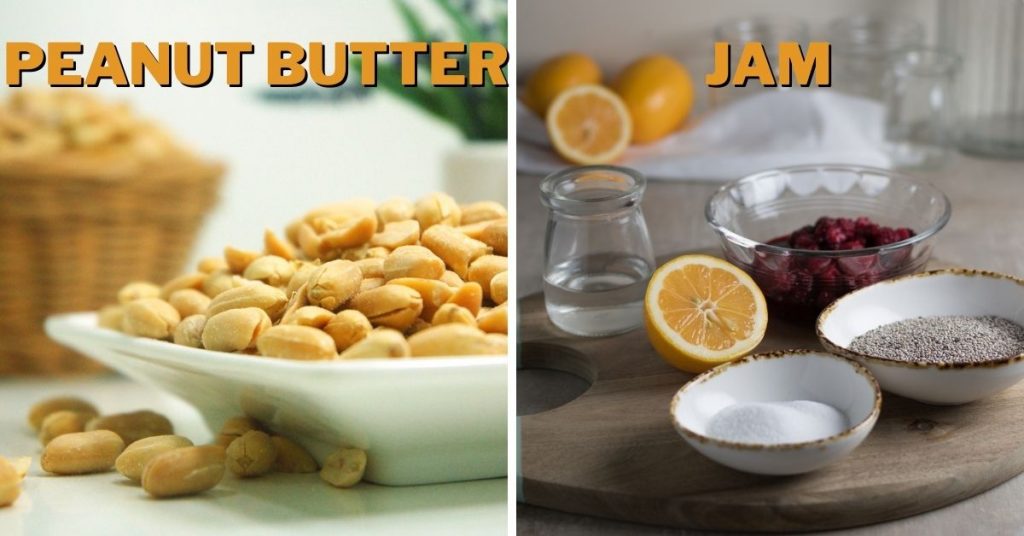Peanut Butter vs. Jam: Differences & Which One Is Better?
Peanut butter and jam are two popular foods that are frequently enjoyed for their exquisite taste and texture. They are often eaten like snacks throughout the day, and many people tend to mix them together. However, even though these products share some similarities, there are also many differences between them. So, what distinguishes peanut butter from jam, and which one is considered better?
The biggest difference between jam and peanut butter is their ingredients list. Peanut butter is made from ground peanuts, while jam contains fruit juice or fruit pieces. Peanut butter is salty, while jam is sweet. Both of them are good for spreading on the bread, but peanut butter is stickier and is more nutritionally valuable.
Most people enjoy the distinctive flavors of jams and peanut butter, but sometimes don’t always remember the differences between these culinary staples. Therefore, this review is set to clear things up once and for all. We will look into their contents, preparation and uses, textures, and nutritional values.
Peanut Butter vs. Jam: Differences
Even though peanut butter and jam go great together, they have huge differences in texture, taste, and nutritional value. So, let’s inspect these differences in detail.
Taste And Ingredients
The most obvious difference between peanut butter and jam is their content. That being said, peanut butter is only made from peanuts, whereas jams can be made from a variety of fruits and even vegetables.
People most often use smaller fruits, such as berries, or soft fruits like strawberries, apricots, and peaches to make jams, which will have a jelly-like form in the end.
Another difference is the presence of pectin and additives. Pectin, which is usually found in the walls of fruits, is a type of starch that thickens and gives jams a semi-compact texture when chilled. This is not the same as peanut butter, which contains no pectin at all. If peanut butter is made according to the original recipe, it shouldn’t contain any additives either.

Preparation And Uses
In the process of making peanut butter, the peanuts are normally ground and dry roasted before being mixed with vegetable oils, sweeteners, salt and dextrose to make a thick paste. The final product comes in two different forms that depend on whether the peanuts are blended fully or there are still small pieces left in the paste.
Crunchy peanut butter is typically eaten with cookies and biscuits, but smooth peanut butter is preferred for sandwiches.
On the contrary, jam is made of fruit. The fruit will be chopped up, boiled in added water, and then mixed. Depending on the type of fruit and how sweet it is by nature, people add additional sweeteners (most usually sugar to get a thick and sticky texture). Store-bought jam also has some preservatives to preserve the fresh taste of a jam.
Texture
Another difference between these two products is their texture. Peanut butter comes in the form of a thick, creamy paste, which makes it difficult to spread on bread. Fruit jams, for the most part, have a smooth texture, which makes the task of spreading them on bread, toast, or crackers much easier. Jams also contain fruit pulp and seeds, sometimes even whole fruits, while peanut butter should be homogenous since it’s made from ground peanuts.
Nutrition Value
When consumed moderately, there are known health benefits to eating peanut butter. Because it has higher levels of monounsaturated fats, consuming peanut butter is said to help prevent cardiovascular disease. [1]
It also contains protein, magnesium, vitamins, all of which are extremely beneficial to our bodies. However, studies are yet to show if there is any health benefit to consuming jams, apart from getting an energy boost.
Peanut butter has a lot of nutrients, but it also contains a lot of calories and fat. While the fats in peanut butter are healthy in general, they should be used in moderation to avoid undesirable weight gain or health problems. Moreover, sugar, vegetable oil, and trans fat oils are frequently added to commercial peanut butter brands, thus reducing their nutritional value.
Jams are a good source of vitamin C and do not contribute to body cholesterol, but they should also be consumed only moderately since they are frequently high in sugar.
Peanut Butter Vs. Jam: Which One to Choose?
Peanut allergy is the most prevalent food allergy in children under the age of 18 and the second-most common one in adults. [2]
Subsequent exposure to peanut protein, usually through oral intake, activates the immune system, resulting in mild to severe response symptoms. Therefore, for many people, consuming anything that contains peanuts, including peanut butter, can have serious, even fatal, health consequences.
It also depends on what you prefer to eat your jam or peanut butter with. Many people seem to think that jam goes better with toast, while peanut butter is perfect for regular white bread. You can even combine them to make the classic peanut butter and jam sandwich, which is a staple snack in some countries. But, taste-wise, peanut butter and jam are the best when eaten together.

Nutritionally, as long as you exercise portion control, eating peanut butter instead of jam will probably be a better option for health enthusiasts. Research suggests peanut butter offers numerous health benefits, such as improved heart health, reduced risk of diabetes, and it even has anti-cancer properties.
Peanut butter made from good quality organic nuts is also frequently included in meal plans made by certified health gurus. However, because of high caloric values, it must be consumed only as part of a balanced diet. Also, remember to avoid commercial brands, or better yet, make your own peanut butter at home!
If you still prefer jam but want to control your sugar intake, you’d be happy to know that nowadays manufacturers produce special jams suited for diabetics, which contain little to no sugar at all.
